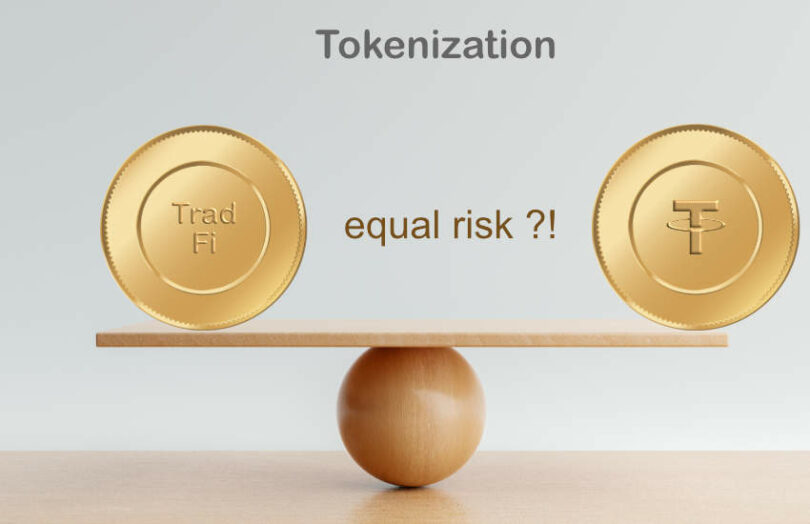Earlier this month, the US Federal Reserve published a paper assessing the financial stability implications of tokenization. While it acknowledges that tokenization volumes are currently insignificant, it warns of a host of potential risks. In several instances, the Fed infers that the volatility witnessed in the cryptocurrency sector will impact tokenization. The document barely differentiates between tokens issued by regulated financial institutions and entirely unregulated crypto firms.
For example, the same table lists Tether gold alongside tokenized bonds issued by the European Investment Bank with help from four global systemically important banks. That’s the same Tether brand that was banned by the New York Attorney General for not always fully backing its stablecoin.
The authors acknowledge the “potential” benefits of tokenization of broadening access to markets, programmability and faster settlement. It notes the possibility of using tokenized assets for collateral and positive impacts on liquidity. Citing academic research on ETFs, it states that ETFs improved the liquidity and pricing in the underlying asset markets and tokenization could do the same.
Financial stability risks of tokenization
However, the warnings around tokenization’s risks to financial stability mirror those regarding cryptocurrencies from a few years ago. The interconnectedness between the digital asset system and traditional finance (TradFi) is the primary concern.
Risks include:
- a firesale in tokenized markets impacting TradFi markets
- volatility from crypto markets transmitted to underlying reference assets
- concerns around under-collateralization triggering a run
- a mismatch between 24/7 token trading versus TradFi trading hours in stress events
- DeFi automated margin calls triggering liquidations
- tokenization (like securitization) masking the risks of underlying assets.
A few of these risks apply to all tokens. But our observation is that some relate to the crypto world, where unregulated entities perform similar roles to regulated ones without supervision and guardrails. We’re not saying there’s never been fraud and mismanagement in TradFi. But the scale of fraud in crypto is unprecedented.
There’s a vast difference between an unregulated firm saying “honest, there really is backing for this token,” and a regulated TradFi custodian sharing the data to prove it.
Analysis: Tokenization and rational fire sales
Two paragraphs from the paper are worth highlighting.
“The inability to meet redemptions may perpetuate the fire-sale, decreasing the value of the asset to the point that it may threaten the solvency of any institution holding a sizeable share of the tokenized asset on its balance sheet. Furthermore, if such an institution would benefit from injections of liquidity from traditional money markets, they would be unable to obtain funding on a weekend.”
This theoretical risk could be a real one. But perhaps it also might be overstated. Firstly, one would hope that “institutions” would sufficiently address diversification to avoid such a risk. If they don’t, then lax risk management is going to surface elsewhere.
Secondly, we’ve already seen the working hours mismatch in the crypto world and people behaved rationally. When Silicon Valley Bank collapsed, the USDC stablecoin lost its peg. Additionally, USDC issuer Circle had to curb redemptions over the weekend because banks were closed. USDC’s price did not drop to zero because people know banks are closed over the weekend. The markets marked down USDC only to the extent of writing off roughly the amount deposited at SVB (before the bailout).
Analysis: Ondo Finance held up as a key risk
“Despite being similar in spirit to J.P. Morgan’s first use of tokenized ownership interests in Money Market Fund (MMF) shares as collateral for repo and securities lending transactions, the impact of Ondo Finance’s initiative on traditional financial markets could be involved in a wider range of uses and create more interconnections.”
Ondo is one of the largest DeFi tokenizations of a BlackRock money market fund ($167 million). If Ondo Finance reached the scale of the large stablecoins – and it could – this one is a real risk. However, a key issue is that Ondo is entirely unregulated. It claims to segregate activities between different entities, but without oversight, one has to rely on its word. It also has a DeFi protocol that lends stablecoins using the tokens as collateral.
This paragraph from the paper is one of the few (or perhaps only) recognitions regarding the difference between TradFi tokenizations and crypto ones. While Ondo is a U.S. entity it is not regulated nor are its tokens. It does not offer tokens to U.S. citizens, taking advantage of regulatory arbitrage. Despite promising asset audits since the start, we have yet to see one. However, that doesn’t imply wrongdoing as few auditors are willing to touch the sector.
Tokenization: the big picture
Given the real potential of tokenization, collaboration is needed to address legitimate regulator concerns. However, there’s also a need to educate regulators to stop treating very different tokens as if they carry the same risks.
Papers such as this might unintentionally give the impression that there’s little point in being regulated. Using regulatory arbitrage, the unregulated get to do as they please, and the regulated are considered just as risky despite incurring all the costs of compliance and supervision.






